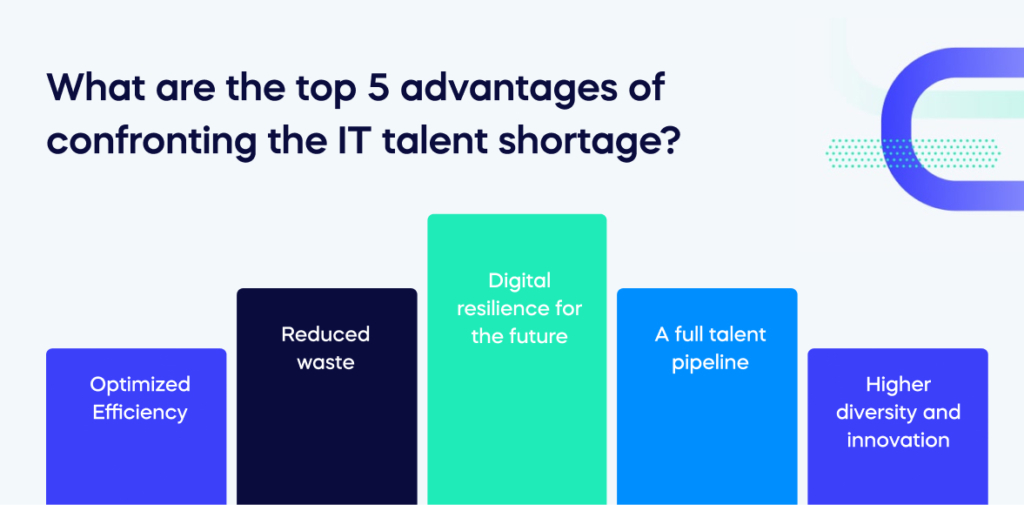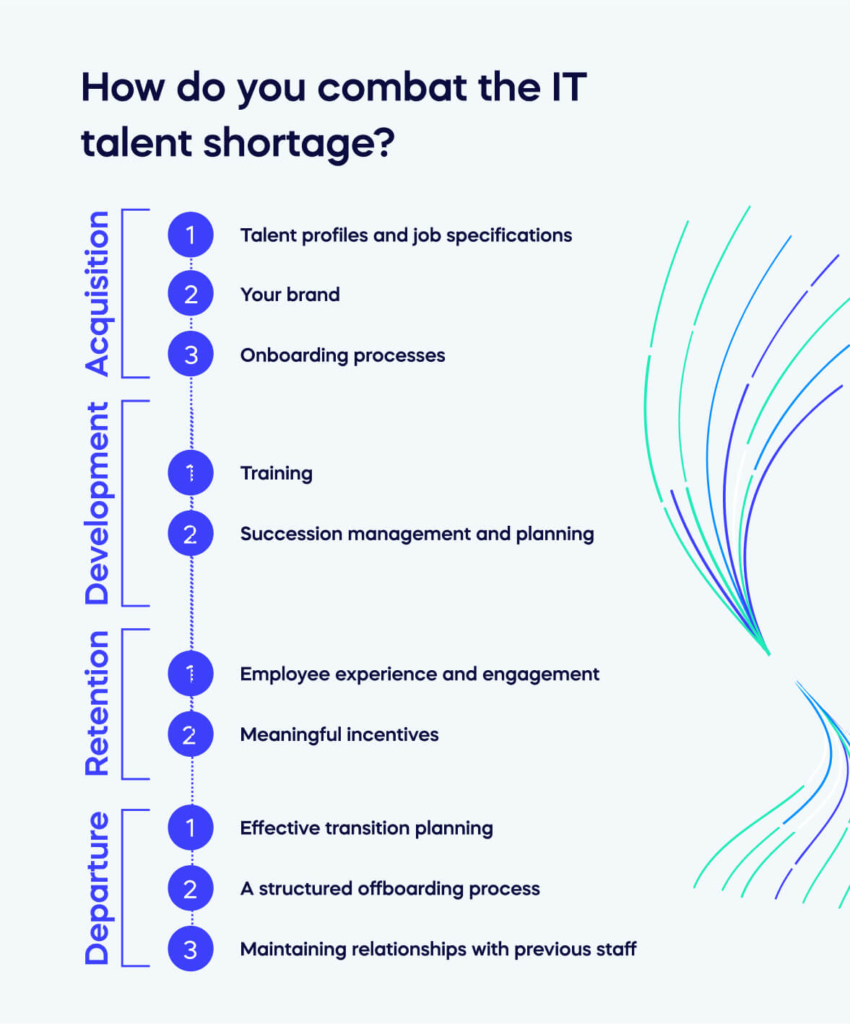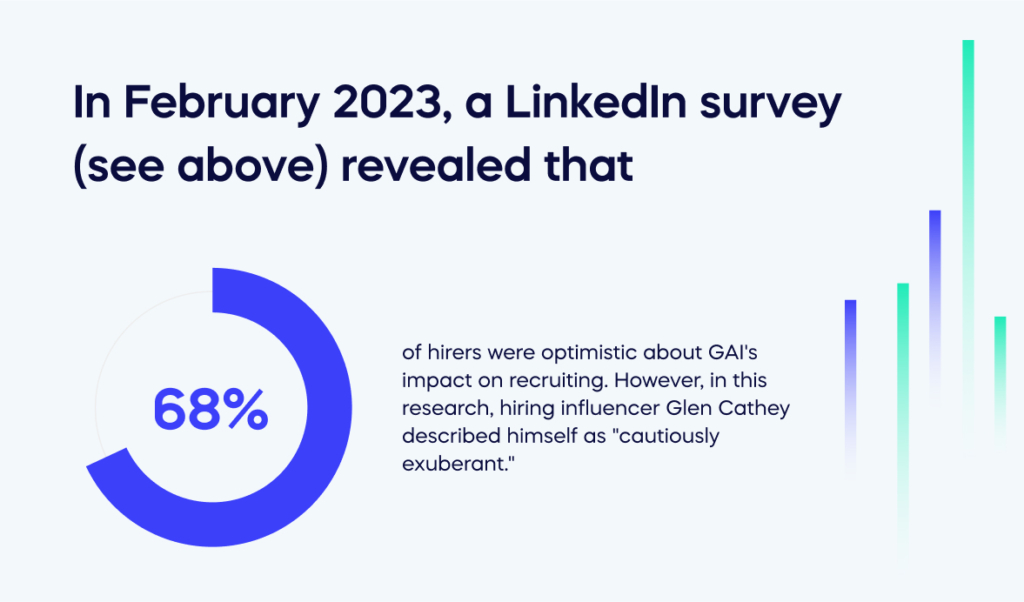Amidst a looming recession, the unemployment rate remains low while the demand for skilled tech workers, particularly in IT, continues to be high.
As critical digital projects are at risk without the proper talent, tech leaders should implement a thorough strategy to locate, recruit, and retain talent to counter tech talent shortages.
LinkedIn research reflects this point in its 2023 Future Of Recruiting Report which found that 87% of recruitment professionals say talent acquisition has become a more strategic goal in the past 12 months.
To help you understand the reasons for the IT talent shortage and combat it to get the right talent, we will explore the following topics:
- Why is the IT talent shortage significant in 2023?
- What are the advantages of filling the IT talent shortage?
- How do you combat the IT talent shortage?
- What role will generative AI play in the IT talent shortage in 2023?
Why is the IT talent shortage significant in 2023?
The background to the IT talent shortage in 2023 lies in how digital transformation is changing the talent needs of companies in the tech marketplace.
Research And Markets predict that worldwide digital transformation will exceed USD 1.5 trillion in 2027, up from approximately USD 595 billion in 2022.
This growth is mainly due to organizations’ ongoing investment in technologies such as AI (artificial intelligence) and ML (machine learning), as well as enterprise software like CRM and ERP systems.
Due to the increasing investments in technology, a high demand for skilled technical professionals to handle implementation, maintenance, and security tasks creates a tight talent market where talented employees are in tall order.
However, many IT leaders face difficulties finding the right talent due to a global talent shortage, particularly in fields like IT and data, where demand is high.
Despite the Bureau of Labor Statistics reporting that the unemployment rate was under 4% throughout 2022, there continues to be a shortage of technical workers in 2023, indicating that the issue is not simply due to a lack of willingness to work.
Although there have been layoffs in the tech industry, many affected workers were not in technology roles and, therefore, cannot contribute to addressing the technology shortage.
Additionally, technology has advanced significantly in the past decade, resulting in a growing demand for skilled professionals that cannot meet market needs due to a shortage of qualified individuals creating a talent gap.
What are the top 5 advantages of confronting the IT talent shortage?

Knowing the benefits of confronting the ongoing talent shortage can be challenging. Let’s look at the five top advantages to allow you to see the incentives in facing this IT talent shortage.
1. Optimized Efficiency
A solid talent acquisition process can make hiring quicker and more effective to help you attract talent despite the global talent crunch.
If you need help handling it internally, consider hiring a specialist in talent acquisition. Doing so could lead to lower costs and help you to keep pace with your hiring demands.
2. Reduced waste
Implementing an effective talent acquisition process can lead to cost savings. According to SHRM, recruiting a new employee can cost up to USD 4,700, and if you need to hire multiple employees, the costs can accumulate rapidly.
To minimize this, make sure you can hire people quickly. A ready-made talent pool will save you time on advertising job openings, screening candidates, and sourcing.
You can save money on talent acquisition costs by avoiding using multiple recruiting tools, posting job openings, and hiring external recruiters.
3. Digital resilience for the future
Digital resilience and planning for how tech will influence what talent you will need in the future are significant factors to consider in attracting talent during a shortage.
Having a talent acquisition coordinator can also assist you with future preparations. Their talent acquisition process intends to foresee the types of jobs you will require and the necessary talent to fill those positions.
Strategic talent acquisition involves hiring individuals for the job and their potential to advance within the company and become future leaders. The process consists of seeking out talented candidates, even for entry-level positions.
4. A full talent pipeline
You can proactively build a talent pipeline by identifying and engaging with qualified candidates to prepare for future hiring needs. Doing so lets you draw from your pool of potential candidates when you have job openings.
To develop a pool of potential candidates, consider attending networking events, collaborating with universities, providing professional development opportunities, or joining career communities. This action lets you identify individuals to establish relationships for your talent pipeline.
5. Higher diversity and innovation
Candidates often view a diverse work environment as necessary when considering job opportunities.
Moreover, having a diverse workforce can bring several advantages to your company. It can lead to various perspectives and ideas, enhancing productivity and innovation.
It is helpful to know these advantages to get an overview of the benefits of investing in bridging the IT talent shortage gap and ensuring you receive all the rewards.
How do you combat the IT talent shortage?

Follow our four steps, each with its action points, to combat the global IT talent shortage and acquire the best talent for your organization despite the limited talent pool and high competition for IT talent in 2023.
Step 1: Acquisition
To hire the best candidates, concentrate on these four essential recruitment factors: identification, attraction, selection, and retention of top talent.
Action point 1: Talent profiles and job specifications
Job specifications should emphasize the desired outcomes and core competencies instead of just listing technical skills and credentials.
Lengthy lists of qualifications limit the pool of potential applicants, even those who are qualified.
It is essential to explain how the role you are advertising aligns with the aspects of your organization, such as:
- Your organization’s mission and strategy.
- The impact of the role and your organization on society.
- Personal and professional development opportunities the position offers.
Action point 2: Your brand
Ensure your IT organization’s brand is well-cultivated and positioned to attract the best digital talent. Presenting an appealing employer brand includes communicating and delivering a strong employee value proposition that appeals to candidates and employees.
To ensure diversity, equity, and inclusion, utilize a tech-based recruitment process that uses data and artificial intelligence tools to screen and identify top talent quickly and effectively. These tools can also help personalize the candidate experience.
Action point 3: Onboarding processes
A successful onboarding process can establish a positive and lasting partnership between employees and organizations, as it defines expectations for an excellent employee experience.
Extending the orientation process from a few weeks to six months or even a year is advisable to ensure employees assimilate with the company culture and have enough time to evaluate and improve their skills to meet performance expectations.
Doing so is crucial in hybrid or remote work settings where the company culture may be more separate.
Step 2: Development
To ensure that the workforce keeps up with the evolving needs of digital business, prioritize these two essential tasks training, succession management, and planning.
Action point 1: Training
Instead of hiring new talent for digital business needs, focus on identifying and developing the skills of your current workforce.
Encourage a culture of upskilling and reskilling, where top IT employees can pursue customized learning paths to expand their capabilities and become more valuable assets.
Consider implementing Connector managers who can understand employee motivations and help them grow.
The best way to train staff efficiently, in a personalized routine that prevents one-to-one training, is by using a DAP, with its in-app guidance and ability to allow the team to train as they use new digital tools.
Action point 2: Succession management and planning
C-suites are dealing with disruptions such as influential leaders retiring and skilled talent leaving, making the talent market more competitive.
By implementing succession planning and management as an ongoing process, organizations can better prepare for these changes:
- Recover quickly from any interruptions.
- Take advantage of new opportunities.
- Be assured that there is skilled IT talent available to fulfill essential roles.
Step 3: Retention
Develop a total rewards strategy to motivate and retain employees in the long run by analyzing the factors that affect employee engagement using retention strategies.
Action point 1: Employee experience and engagement
It’s essential to compare their scores with benchmarks and identify improvement areas for employee engagement.
Due to the shift towards remote IT teams, adopting a leadership style that prioritizes empathy and intuitiveness is essential to ensure that employees remain healthy, motivated, and productive.
Conducting pulse surveys will help collect feedback to gauge the effectiveness of hybrid/remote workplace designs and improve the overall employee experience.
Action point 2: Meaningful incentives
While offering competitive pay to attract skilled IT professionals is essential, relying solely on money is insufficient to ensure their engagement, drive, and loyalty.
To deliver a comprehensive employee value proposition, organizations should adopt a total rewards strategy incorporating five key components:
- Competitive compensation.
- Work-life balance.
- Ongoing career development.
- Meaningful benefits package.
- Performance recognition.
Develop customized employment packages that cater to employees’ individual needs and priorities to ensure the above strategy is effective.
For instance, for employees working in the public sector who may not receive the highest compensation, emphasize other perks such as a sense of purpose and shared goals.
Step 4: Departure
Transition planning and offboarding are as crucial as onboarding because former employees can become the company’s valuable customers, partners, or brand advocates.
Action point 1: Effective transition planning
When planning for employee transitions, it’s essential to consider all job changes, including promotions, transfers, mergers and acquisitions, and layoffs.
This action point helps ensure a positive experience for employees as they enter, move through, and leave the organization.
Pay particular attention to leadership transitions, which you can streamline via programs like high-potential development plans, mentoring, and buddy systems.
Action point 2: A structured offboarding process
It’s essential to give as much attention to offboarding as onboarding. If an employee leaves voluntarily, conduct an exit interview where they feel comfortable sharing their reasons for leaving and provide helpful feedback on what’s effective and what’s not.
Use that feedback to enhance employee engagement and retention methods for the future. Ideally, the process should connect with succession planning and management practices.
It would be advantageous if internal candidates, particularly for crucial and leadership roles, were already identified to take over the upcoming vacant position.
Action point 3: Maintaining relationships with previous staff
Organizations often underutilize alum relationships.
Many big companies have groups on social media websites like LinkedIn. These people can help you find employees, customers, and people who can tell you things that will be useful.
Follow these four steps to combat the IT talent shortage, attracting and retaining the best talent.
What role will generative AI play in the IT talent shortage in 2023?
Generative AI (GAI) will be critical in filling the IT talent shortage in 2023.
Talent professionals are interested in utilizing Generative AI (GAI) tools such as ChatGPT, which can generate content and save time on tasks like creating job descriptions and personalized messages for candidates.
This emerging technology is up-and-coming for such uses when confronting the IT talent shortage.
In February 2023, a LinkedIn survey (see above) revealed that 68% of hirers were optimistic about GAI’s impact on recruiting. However, in this research, hiring influencer Glen Cathey described himself as “cautiously exuberant.”

GAI can save recruiters time and allow them to concentrate on the most human parts of their jobs, such as listening to candidates, understanding their needs, and assisting them in finding a job they will enjoy.
Despite GAI being able to assist in creating content, it is essential to have a human review and refine the generated content.
The upshot is that a person with the necessary expertise should always be present to ensure accuracy, so a human employee will still need to be in control and oversee the process.
Invest in filling the IT talent shortage to benefit every department
In today’s digital age, it can be challenging for businesses to find and keep experienced IT personnel. Departments may struggle with technology without investing in a comprehensive hiring strategy and employee incentives to fill IT talent shortages.
Focusing on longer-term jobs involving long-term career growth and development opportunities is essential to attract the top IT talent needed for success.
Investing in filling the IT talent shortage can benefit every department within any given company and become critical to success in this ever-changing technological landscape.
As such, it is time for businesses across industries to address their shortfalls to guarantee both digital health and appropriate staffing now and into the future.

